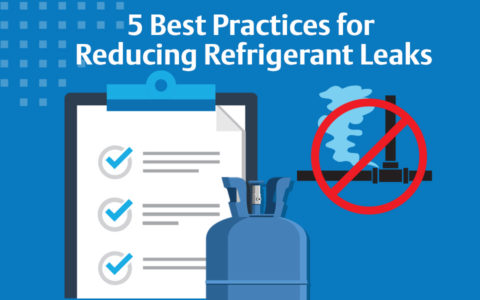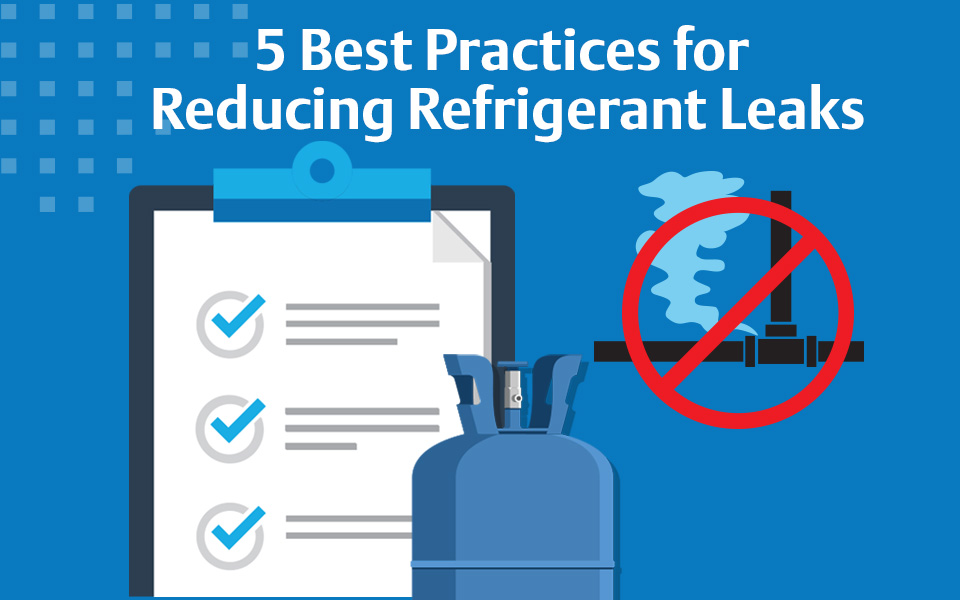5 Best Practices for Reducing Refrigerant Leaks

The goal of minimizing refrigerant leaks in commercial refrigeration systems has always been a worthwhile endeavor for food retailers. Leaky systems can negatively impact performance, potentially causing cases to warm, product quality to suffer, and energy efficiency to decline. But as the phasedown of hydrofluorocarbon (HFC) refrigerants progresses in the U.S. — and HFC prices continue to rise — topping off leaking refrigeration systems is becoming an expensive proposition. In a recent AHRI webinar, I discussed the importance of prioritizing leak detection and reduction efforts and explored available technologies. A summary of this webinar also appeared in an article by ACHR The News.

Of course, employing an effective leak detection system is essential to any leak management program. But before I discuss leak detection strategies and technologies, it’s important to consider the following best practices for reducing refrigerant leaks:
- Take inventory of refrigerant supplies. Completing a comprehensive refrigerant inventory evaluation lets everyone in your organization know how much refrigerant is available in each facility and where it is located. It is not enough to know that 10,000 pounds of refrigerant is available across all stores. Organizations must uncover in greater detail how much refrigerant is available, where it is stored, and at what quantity.
- Track refrigerant usage and/or leaks. Retailers need to know precisely where refrigerant is being consumed and where the biggest leak offenders are taking place. This requires robust recordkeeping and the ability to continuously update refrigerant usage and/or leak information. In addition, having this data on hand is essential to establishing leak management policies and procedures needed to meet regulatory requirements.
- Don’t top-off leaks, repair them. Lowering leak rates means repairing them as quickly as they are detected. Topping off leaky systems with more refrigerant is simply not an environmentally or financially responsible practice. Organizations need to adopt a zero-tolerance policy regarding leaks that include inventory management, leak detection technologies and periodic case inspections.
- Replace or upgrade refrigeration systems. Many organizations reach a point when it is simply not feasible to keep repairing equipment, especially as refrigerant costs rise and refrigerant transitions become a higher priority. This decision should be made by monitoring systems for excess cycling, increased electricity usage and overall declining performance.
- Set, and meet, refrigerant usage goals. Commit to reducing refrigerant usage and lowering leak rates by setting company-wide and facility-specific goals based on a targeted percentage reduction. Make everyone in the organization aware of these goals so that stakeholders work toward a shared — and achievable — objective.
Understanding leak detection strategies and technologies
Implementing these best practices will require retailers to deploy technologies that not only enable early and accurate leak detection, but also help maintain the documentation needed to track program metrics and support regulatory compliance. Copeland has developed robust solutions in the three primary leak detection categories: active, passive and indirect.
Active leak detection systems are designed to identify refrigerant leaks quickly and minimize refrigerant loss. These aspirated systems are based on infrared technology to deliver centralized, multi-zone leak detection from four to 16 zones. Additional benefits include audible alarms and/or the option to communicate through Modbus or BACnet to a central building management system (BMS) — both of which are essential to notify service personnel when a leak is occurring. Copeland’s RDLS Multi-Zone leak detector is an ideal option for retailers seeking an active solution.
Passive leak detection systems are typically based on infrared or semiconductor technologies and are ideal for safety compliance purposes. These refrigerant-specific devices are usually installed in specific areas of a facility, such as walk-in coolers, freezers or machine rooms. Copeland’s MRLDS-450 is a semiconductor-based instrument, while the MRLDS-250 utilizes infrared technology. Connect them to our E3 supervisory control platform for a BMS-level communication and enhance leak detection visibility.
Indirect leak detection systems are typically installed at the refrigeration rack level. These leverage existing sensors and/or hardware to capture temperature, pressure and liquid level data that is then processed through machine learning (ML) algorithms. For retailers seeking to deploy an indirect leak detection strategy, Copeland’s E3 control features proprietary ML algorithms designed to identify deviations in incoming data and provide early detection of the presence of leaks.
To learn more about Copeland’s robust refrigerant leak detection solutions, please visit our website.

Six Ways to Reduce Food Waste by Tracking the Supply Chain
by Gerd Uitdewilligen | Cold Chain
*Emerson’s Climate Technologies business is now a new standalone company: Copeland. Over the next...

Protect Valuable Shipments in High-Crime Areas
by Lissandra Rodriguez | Cold Chain
*Emerson’s Climate Technologies business is now a new standalone company: Copeland. Over the next...

Real-time Tracking Protects Valuable Mango Cargo
by Andres Toro | Cold Chain
*Emerson’s Climate Technologies business is now a new standalone company: Copeland. Over the next...
The post 5 Best Practices for Reducing Refrigerant Leaks appeared first on Copeland.